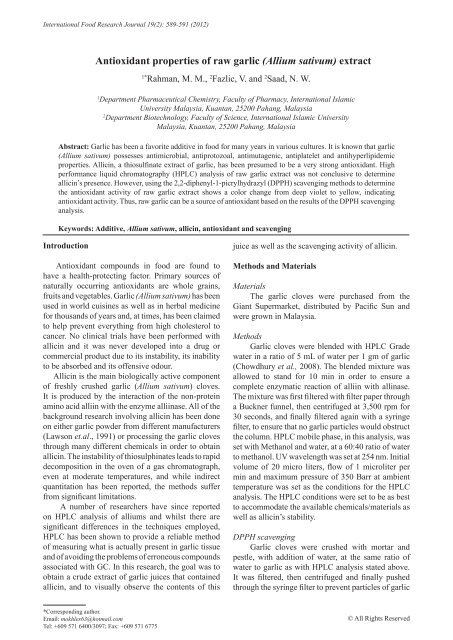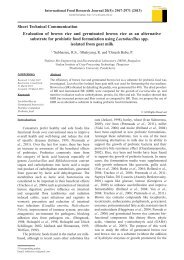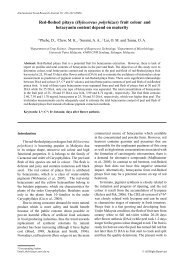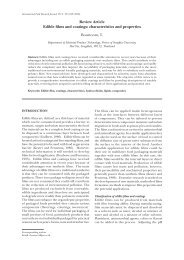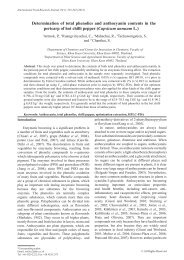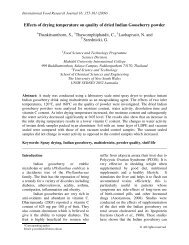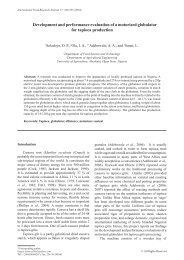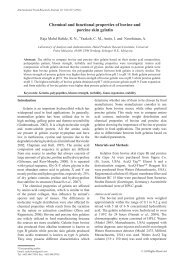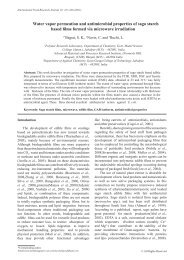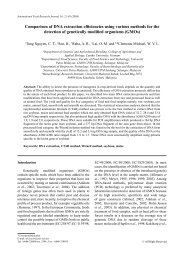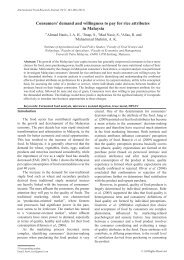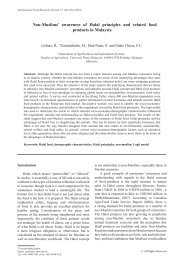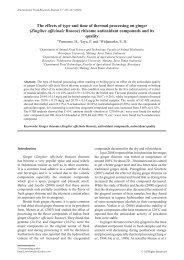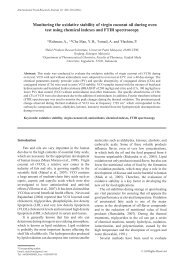Antioxidant properties of raw garlic (Allium sativum ... - Ifrj.upm.edu.my
Antioxidant properties of raw garlic (Allium sativum ... - Ifrj.upm.edu.my
Antioxidant properties of raw garlic (Allium sativum ... - Ifrj.upm.edu.my
Create successful ePaper yourself
Turn your PDF publications into a flip-book with our unique Google optimized e-Paper software.
International Food Research Journal 19(2): 589-591 (2012)<br />
<strong>Antioxidant</strong> <strong>properties</strong> <strong>of</strong> <strong>raw</strong> <strong>garlic</strong> (<strong>Allium</strong> <strong>sativum</strong>) extract<br />
1*<br />
Rahman, M. M., 2 Fazlic, V. and 2 Saad, N. W.<br />
1<br />
Department Pharmaceutical Chemistry, Faculty <strong>of</strong> Pharmacy, International Islamic<br />
University Malaysia, Kuantan, 25200 Pahang, Malaysia<br />
2<br />
Department Biotechnology, Faculty <strong>of</strong> Science, International Islamic University<br />
Malaysia, Kuantan, 25200 Pahang, Malaysia<br />
Abstract: Garlic has been a favorite additive in food for many years in various cultures. It is known that <strong>garlic</strong><br />
(<strong>Allium</strong> <strong>sativum</strong>) possesses antimicrobial, antiprotozoal, antimutagenic, antiplatelet and antihyperlipidemic<br />
<strong>properties</strong>. Allicin, a thiosulfinate extract <strong>of</strong> <strong>garlic</strong>, has been presumed to be a very strong antioxidant. High<br />
performance liquid chromatography (HPLC) analysis <strong>of</strong> <strong>raw</strong> <strong>garlic</strong> extract was not conclusive to determine<br />
allicin’s presence. However, using the 2,2-diphenyl-1-picrylhydrazyl (DPPH) scavenging methods to determine<br />
the antioxidant activity <strong>of</strong> <strong>raw</strong> <strong>garlic</strong> extract shows a color change from deep violet to yellow, indicating<br />
antioxidant activity. Thus, <strong>raw</strong> <strong>garlic</strong> can be a source <strong>of</strong> antioxidant based on the results <strong>of</strong> the DPPH scavenging<br />
analysis.<br />
Keywords: Additive, <strong>Allium</strong> <strong>sativum</strong>, allicin, antioxidant and scavenging<br />
Introduction<br />
<strong>Antioxidant</strong> compounds in food are found to<br />
have a health-protecting factor. Primary sources <strong>of</strong><br />
naturally occurring antioxidants are whole grains,<br />
fruits and vegetables. Garlic (<strong>Allium</strong> <strong>sativum</strong>) has been<br />
used in world cuisines as well as in herbal medicine<br />
for thousands <strong>of</strong> years and, at times, has been claimed<br />
to help prevent everything from high cholesterol to<br />
cancer. No clinical trials have been performed with<br />
allicin and it was never developed into a drug or<br />
commercial product due to its instability, its inability<br />
to be absorbed and its <strong>of</strong>fensive odour.<br />
Allicin is the main biologically active component<br />
<strong>of</strong> freshly crushed <strong>garlic</strong> (<strong>Allium</strong> <strong>sativum</strong>) cloves.<br />
It is produced by the interaction <strong>of</strong> the non-protein<br />
amino acid alliin with the enzyme alliinase. All <strong>of</strong> the<br />
background research involving allicin has been done<br />
on either <strong>garlic</strong> powder from different manufacturers<br />
(Lawson et.al., 1991) or processing the <strong>garlic</strong> cloves<br />
through many different chemicals in order to obtain<br />
allicin. The instability <strong>of</strong> thiosulphinates leads to rapid<br />
decomposition in the oven <strong>of</strong> a gas chromatograph,<br />
even at moderate temperatures, and while indirect<br />
quantitation has been reported, the methods suffer<br />
from significant limitations.<br />
A number <strong>of</strong> researchers have since reported<br />
on HPLC analysis <strong>of</strong> alliums and whilst there are<br />
significant differences in the techniques employed,<br />
HPLC has been shown to provide a reliable method<br />
<strong>of</strong> measuring what is actually present in <strong>garlic</strong> tissue<br />
and <strong>of</strong> avoiding the problems <strong>of</strong> erroneous compounds<br />
associated with GC. In this research, the goal was to<br />
obtain a crude extract <strong>of</strong> <strong>garlic</strong> juices that contained<br />
allicin, and to visually observe the contents <strong>of</strong> this<br />
juice as well as the scavenging activity <strong>of</strong> allicin.<br />
Methods and Materials<br />
Materials<br />
The <strong>garlic</strong> cloves were purchased from the<br />
Giant Supermarket, distributed by Pacific Sun and<br />
were grown in Malaysia.<br />
Methods<br />
Garlic cloves were blended with HPLC Grade<br />
water in a ratio <strong>of</strong> 5 mL <strong>of</strong> water per 1 gm <strong>of</strong> <strong>garlic</strong><br />
(Chowdhury et al., 2008). The blended mixture was<br />
allowed to stand for 10 min in order to ensure a<br />
complete enzymatic reaction <strong>of</strong> alliin with allinase.<br />
The mixture was first filtered with filter paper through<br />
a Buckner funnel, then centrifuged at 3,500 rpm for<br />
30 seconds, and finally filtered again with a syringe<br />
filter, to ensure that no <strong>garlic</strong> particles would obstruct<br />
the column. HPLC mobile phase, in this analysis, was<br />
set with Methanol and water, at a 60:40 ratio <strong>of</strong> water<br />
to methanol. UV wavelength was set at 254 nm. Initial<br />
volume <strong>of</strong> 20 micro liters, flow <strong>of</strong> 1 microliter per<br />
min and maximum pressure <strong>of</strong> 350 Barr at ambient<br />
temperature was set as the conditions for the HPLC<br />
analysis. The HPLC conditions were set to be as best<br />
to accommodate the available chemicals/materials as<br />
well as allicin’s stability.<br />
DPPH scavenging<br />
Garlic cloves were crushed with mortar and<br />
pestle, with addition <strong>of</strong> water, at the same ratio <strong>of</strong><br />
water to <strong>garlic</strong> as with HPLC analysis stated above.<br />
It was filtered, then centrifuged and finally pushed<br />
through the syringe filter to prevent particles <strong>of</strong> <strong>garlic</strong><br />
*Corresponding author.<br />
Email: mokhles63@hotmail.com<br />
Tel: +609 571 6400/3097; Fax: +609 571 6775<br />
© All Rights Reserved
590 Rahman, M. M., Fazlic, V. and Saad, N. W.<br />
from affecting the study. The solution was allowed<br />
10 min to complete the enzyme reaction.<br />
DPPH and Trolox solutions were prepared<br />
daily, a 1:1 ratio <strong>of</strong> <strong>garlic</strong> sample was mixed with<br />
DPPH; where within seconds the scavenging activity<br />
was visible to the naked eye. Fifteen min after 2,2-<br />
diphenyl-1-picrylhydrazyl (DPPH) was added, the<br />
sample was placed into a spectrophotometer and<br />
absorbance was evaluated between 400 and 750 nm<br />
(Prakash et al., 2001; Molyneux, 2004; Marksen<br />
et al., 2007). Trolox solution was also mixed with<br />
DPPH, at a 1:1 ratio, in order to produce the positive<br />
control for these samples. DPPH solution alone was<br />
used as a negative control.<br />
Results and Discussion<br />
Garlic (<strong>Allium</strong> <strong>sativum</strong>) has been used as a<br />
remedy and health-promoter for 5,000 years. The<br />
chemistry <strong>of</strong> <strong>garlic</strong> is extremely complex, but<br />
research has shown that it is the unusual organosulfur<br />
compounds relatively unique to <strong>garlic</strong> that promote<br />
its broad range <strong>of</strong> lipid-lowering, antithrombotic,<br />
anti-blood coagulation, anti-hypertension, anticancer,<br />
antioxidant, and antimicrobial effects. The most wellknown<br />
and widely studied <strong>garlic</strong> compound is allicin.<br />
When fresh <strong>garlic</strong> cloves are crushed or chopped, or<br />
<strong>garlic</strong> powder that has been carefully dried is added to<br />
water, allicin is produced in seconds. Allicin and other<br />
thiosulfinates are somewhat unstable, but dilution<br />
and dissolving in water can greatly improve their<br />
stability. Allicin can decompose into a broad range<br />
<strong>of</strong> compounds, including S-allylmercaptocysteine,<br />
allylmercaptan, diallyl disulfide, allylmethyl disulfide,<br />
vinyldithiins, ajoene, and possibly allylsulfinic and<br />
allylsulfonic acid.<br />
Analysis <strong>of</strong> allicin has been difficult because<br />
<strong>of</strong> its instability. Direct GC determination has not<br />
been achieved because allicin undergoes rapid<br />
decomposition in the oven <strong>of</strong> a GC, even at moderate<br />
temperatures. It had been attempted once during this<br />
investigation, and the GC-MS was not able to detect<br />
anything, at 0.1µL <strong>of</strong> sample to 0.9 µL <strong>of</strong> Heptane.<br />
The most promising method for analysis <strong>of</strong> allicin<br />
has been found to be reversed-phase HPLC (Lawson<br />
et al., 1991). The area under the peak <strong>of</strong> the HPLC<br />
graph is proportional to the amount <strong>of</strong> a certain<br />
chemical which has passed the detector while the<br />
retention time is indicative <strong>of</strong> the size <strong>of</strong> the certain<br />
molecule. In this study, our results (Figure 2) are<br />
in general agreement with the results published by<br />
Rabinkov et al. (1997) as shown in Figure 1. Possible<br />
reasons for differences in the peak area could be<br />
due to the difference in mobile phases, the HPLC<br />
conditions and the type <strong>of</strong> column used, as well as<br />
the possibility that because <strong>of</strong> allicin’s instability,<br />
even the ambient temperature and pressure causes it<br />
to further decompose.<br />
Figure 1. Published article (Rabinkov et al., 1997), graph<br />
Figure and 1. Published specifications article (Rabinkov <strong>of</strong> allicin et al., HPLC 1997), graph method and<br />
specifications <strong>of</strong> allicin HPLC method<br />
In this study, the <strong>garlic</strong> powders were blended in<br />
Ultrashear homogenizer for one min using 10 mL <strong>of</strong><br />
water per gram <strong>of</strong> <strong>garlic</strong>. The homogenate was allowed<br />
to stand at room temperature for five min, filtered and<br />
injected directly into the HPLC. Elsewhere, Rosen et<br />
al. (2001) found that isocratically using the mobile<br />
phase <strong>of</strong> ACN/H 2<br />
O at 30:70 and with quantitation<br />
at 195 nm can be used to determine the presence <strong>of</strong><br />
allicin. Though various methods have been shown to<br />
be able to be use in extracting allicin, none <strong>of</strong> them<br />
are applicable to the general public. The extraction<br />
method used in this study is considered to be suitable<br />
for application by the general public with minimum<br />
facilities. Garlic itself has many complex substances<br />
that are effective against diseases.<br />
Figure 2. HPLC graph and peaks <strong>of</strong> retention times<br />
Figure 2. HPLC graph and peaks <strong>of</strong> retention times<br />
Parasad et al. (1995) report that the antioxidant<br />
activities <strong>of</strong> Allicin through HPLC should be<br />
complemented with other chemicals to observe its<br />
scavenging activities. In this study, the scavenging<br />
activities were determines by DPPH testing, which<br />
was found to be a rapid, easy and economical method<br />
to measure antioxidant activities. <strong>Antioxidant</strong><br />
activity <strong>of</strong> the sample can be merely viewed by the<br />
naked eye. When DPPH was placed into a vial <strong>of</strong><br />
the sample, within seconds, the deep purple colour<br />
<strong>of</strong> DPPH started disappearing, and within less than<br />
ten min, the sample and DPPH mixture turned a<br />
pale yellow, almost clear colour. When the samples<br />
were analysed using the spectrophotometer, it was<br />
graphically visible that at 520 nm, the absorbance<br />
International Food Research Journal 19(2): 589-591
<strong>Antioxidant</strong> <strong>properties</strong> <strong>of</strong> <strong>raw</strong> <strong>garlic</strong> (<strong>Allium</strong> <strong>sativum</strong>) extract 591<br />
<strong>of</strong> DPPH was centered in the negative control, and<br />
completely absent at the positive control <strong>of</strong> Trolox, as<br />
well as the sample itself in Figure 3. DPPH is widely<br />
used to test the ability <strong>of</strong> compounds to act as free<br />
radical scavengers or hydrogen donors, and to assess<br />
antioxidant activity <strong>of</strong> foods. DPPH process can be<br />
used for solid or liquid samples and is not specific to<br />
any particular antioxidant component, but applies to<br />
the overall antioxidant capacity <strong>of</strong> a sample (Parasad<br />
et al., 1995). Hence, from the results obtained in this<br />
study, the DPPH test is a reliable method to determine<br />
the antioxidant ability <strong>of</strong> <strong>raw</strong> extract from <strong>garlic</strong>.<br />
Laboratories Analytical Progress. Plymouth Ave<br />
North, Minneapolis 1-4.<br />
Rabinkov, A., Miron, T., Konstantinovski, L., Wilchek, M.,<br />
Mirelman, D. and Weiner, L. 1997. The mode <strong>of</strong> action<br />
<strong>of</strong> allicin: trapping <strong>of</strong> radicals and interaction with<br />
thiol containing proteins. Biochimica ei Biophysica<br />
Acta 137: 233-244.<br />
Rosen, R.T, Hiserodt, R. D., Fukuda, E. K., Ruiz, R. J.,<br />
Zhou, Z., Lech, J., Rosen, S. L. and Hartman, T. G.<br />
2001. Determination <strong>of</strong> Allicin, S-Allylcysteine and<br />
Volatile Metabolites <strong>of</strong> Garlic in Breath, Plasma or<br />
Simulated Gastric Fluids. Journal <strong>of</strong> Nutrition 131:<br />
968S-971S.<br />
Sample with DPPH<br />
DPPH<br />
Trolox with<br />
DPPH<br />
Figure 3. Spectrophotometric analysis <strong>of</strong> <strong>garlic</strong><br />
Figure 3. antioxidant Spectrophotometric activity analysis (against <strong>of</strong> <strong>garlic</strong> Methanol) antioxidant activity<br />
(against Methanol)<br />
References<br />
Ankir, S., Miron, T., Rabinkov, A., Wilchek, M. and<br />
Mirelman, D. 1997. Allicin from <strong>garlic</strong> strongly<br />
inhibits cysteine proteinases and cytopathic effects<br />
<strong>of</strong> Entamoeba histolytica Antimicrobial Agents and<br />
Chemotherapy 41: 2286-2288.<br />
Chowdhury, R., Dutta, A., Chaudhuri, S. R., Sharma, N.,<br />
Giri, A. K. and Chaudhuri, K. 2008. In vitro and in<br />
vivo r<strong>edu</strong>ction <strong>of</strong> sodium arsenite induced toxicity<br />
by aqueous <strong>garlic</strong> extract.” Food and Chemical<br />
Toxicology 46: 740-751.<br />
Lawson, L. D., Wood, S. G. and Hughes, B. 1991. HPLC<br />
Analysis <strong>of</strong> Allicin and Other Thiosulfinates in Garlic<br />
Clove Homogenates. Planta Medica 57(3): 263-270.<br />
Lawson, L.D., Wang, Z. J and Hughes, B. G. 1991.<br />
Identification and HPLC quantitation <strong>of</strong> the sulfides<br />
and dialk(en)yl thiosulfinates in commercial <strong>garlic</strong><br />
products. Planta Medica 57(4): 363-70.<br />
Marksen, K., Venselow, K. H., Lippemeier, S., Hintze, R.,<br />
Ruser, A. and Hansen, U. P. 2007. Determination <strong>of</strong><br />
DPPH radical oxidation caused by methanolic extracts<br />
<strong>of</strong> some microalgal species by linear regression<br />
analysis <strong>of</strong> spectrophotometric measurements. Sensors<br />
7: 2080-2095.<br />
Molyneux, P. 2004. The use <strong>of</strong> stable free radical<br />
diphenylpicrylhydrazyl (DPPH) for estimating<br />
antioxidant activity. Journal <strong>of</strong> Science and Technology<br />
26(2): 211-219.<br />
Parasad, K., Victory,A., Yu, M. and Raney, B. L. 1995.<br />
<strong>Antioxidant</strong> activity <strong>of</strong> allicin, an active principle in<br />
<strong>garlic</strong>. Biomedical and life Science 148(2): 183-189.<br />
Prakash, A. 2001. <strong>Antioxidant</strong> Activity, Medallion<br />
International Food Research Journal 19(2): 589-591


